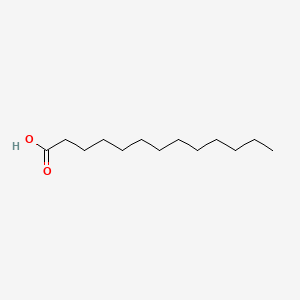| MeSH term | MeSH ID | Detail |
|---|---|---|
| Diabetes Mellitus | D003920 | 90 associated lipids |
TRIDECANOIC ACID
TRIDECANOIC ACID is a lipid of Fatty Acyls (FA) class. Tridecanoic acid is associated with abnormalities such as Fatty Liver, hypoglycemia and Cardiomyopathies. The involved functions are known as Catalyst, Protein Overexpression, Insulin Resistance, Oxidation and Cell Death. Tridecanoic acid often locates in peroxisome, Mitochondria, Protoplasm, Cytosol and Cell membrane. The related lipids are Tridecanoic Acid, Fatty Acids, Fatty Acids, Nonesterified, stearic acid and margaric acid.
Cross Reference
Introduction
To understand associated biological information of TRIDECANOIC ACID, we collected biological information of abnormalities, associated pathways, cellular/molecular locations, biological functions, related genes/proteins, lipids and common seen animal/experimental models with organized paragraphs from literatures.
What diseases are associated with TRIDECANOIC ACID?
TRIDECANOIC ACID is suspected in Fatty Liver, hypoglycemia, Cardiomyopathies and other diseases in descending order of the highest number of associated sentences.
Related references are mostly published in these journals:
| Disease | Cross reference | Weighted score | Related literature |
|---|
Possible diseases from mapped MeSH terms on references
We collected disease MeSH terms mapped to the references associated with TRIDECANOIC ACID
PubChem Associated disorders and diseases
What pathways are associated with TRIDECANOIC ACID
There are no associated biomedical information in the current reference collection.
PubChem Biomolecular Interactions and Pathways
Link to PubChem Biomolecular Interactions and PathwaysWhat cellular locations are associated with TRIDECANOIC ACID?
Visualization in cellular structure
Associated locations are in red color. Not associated locations are in black.
Related references are published most in these journals:
| Location | Cross reference | Weighted score | Related literatures |
|---|
What functions are associated with TRIDECANOIC ACID?
Related references are published most in these journals:
| Function | Cross reference | Weighted score | Related literatures |
|---|
What lipids are associated with TRIDECANOIC ACID?
Related references are published most in these journals:
| Lipid concept | Cross reference | Weighted score | Related literatures |
|---|
What genes are associated with TRIDECANOIC ACID?
There are no associated biomedical information in the current reference collection.
What common seen animal models are associated with TRIDECANOIC ACID?
There are no associated biomedical information in the current reference collection.
NCBI Entrez Crosslinks
All references with TRIDECANOIC ACID
Download all related citations| Authors | Title | Published | Journal | PubMed Link |
|---|---|---|---|---|
| Elsner M et al. | Peroxisome-generated hydrogen peroxide as important mediator of lipotoxicity in insulin-producing cells. | 2011 | Diabetes | pmid:20971967 |
| Hellenbrand J et al. | Fatty acyl-CoA reductases of birds. | 2011 | BMC Biochem. | pmid:22151413 |
| Gall WE et al. | alpha-hydroxybutyrate is an early biomarker of insulin resistance and glucose intolerance in a nondiabetic population. | 2010 | PLoS ONE | pmid:20526369 |
| Hu J et al. | A review on progress in QSPR studies for surfactants. | 2010 | Int J Mol Sci | pmid:20479997 |
| Atherton HJ et al. | Metabolomics of the interaction between PPAR-alpha and age in the PPAR-alpha-null mouse. | 2009 | Mol. Syst. Biol. | pmid:19357638 |
| Smallegange RC et al. | The effect of aliphatic carboxylic acids on olfaction-based host-seeking of the malaria mosquito Anopheles gambiae sensu stricto. | 2009 | J. Chem. Ecol. | pmid:19626371 |
| Le Leu RK et al. | Effect of high amylose maize starches on colonic fermentation and apoptotic response to DNA-damage in the colon of rats. | 2009 | Nutr Metab (Lond) | pmid:19267935 |
| Hernández MA et al. | Biosynthesis of storage compounds by Rhodococcus jostii RHA1 and global identification of genes involved in their metabolism. | 2008 | BMC Genomics | pmid:19077282 |
| Jiang Z et al. | Significant associations of stearoyl-CoA desaturase (SCD1) gene with fat deposition and composition in skeletal muscle. | 2008 | Int. J. Biol. Sci. | pmid:18825276 |
| Vlachy N et al. | Role of the surfactant headgroup on the counterion specificity in the micelle-to-vesicle transition through salt addition. | 2008 | J Colloid Interface Sci | pmid:18164719 |
